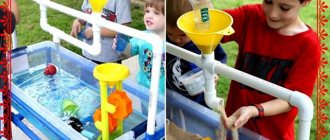Consultation for teachers “Construction and construction games for preschoolers”
Lyudmila Moiseeva
Consultation for teachers “Construction and construction games for preschoolers”
Design is a purposeful process that results in a specific real product. Children's construction is closely related to play and is an activity that meets the interests of children.
Creativity in design is already observed in younger preschoolers (for example, in choosing an object to build, in new uses of well-known structures). Throughout preschool age, children develop the ability to make changes in construction methods so that the building obeys the requirements of the situation. For older preschoolers, indicators of creativity in constructive activities are the novelty of ways to construct an object, the novelty of the object itself, and the novelty of techniques for imparting stability to the structure being constructed.
In the process of learning to design, children develop generalized methods of action and the ability to purposefully examine objects or samples of buildings and toys. Children learn to plan work, presenting it as a whole, learn to control their actions, and correct mistakes independently. All this makes the design process organized and thoughtful.
Construction is one of those types of activities that are of a modeling nature and is important, first of all, for the development of a child’s figurative and elements of visual-schematic thinking, the formation of his ideas about the holistic image of an object. This specific focus of design distinguishes it from other types of activities.
Mastering construction helps expand the vocabulary and enrich children's speech, since in the process of work children share their ideas, learn to motivate them, communicating with each other, carrying out constructive actions, analyzing objects, planning upcoming activities with the help of an adult, giving a verbal report on the actions taken and etc., the child learns the necessary words in connection with the needs of other activities, which contributes to the formation of the correct meaning of words and ways of using them.
Features of design and construction games for preschoolers
In the history of pedagogy, constructive games have been described quite a long time ago and are represented in many systems of education for preschool children (F. Froebel’s system, “Waldorf pedagogy”, K. K Schleger’s system).
This type of game has been thoroughly studied in domestic preschool pedagogy (V. G. Nechaeva, Z. V. Lishtvan, A. N. Davidchuk, L. A. Paramonova).
Constructive and construction games belong to the leading class of games for preschool children - amateur, creative games (S. L. Novoselova, V. V. Zvorygina, L. A. Paramonova).
Features of design and construction games:
- children displaying activity that is proactive and creative in nature;
- replacement of some items with others;
— indirect participation of adults in their preparation and conduct;
- based on children’s constructive skills and abilities;
— the content of these games are children’s impressions of the surrounding objective world;
- this is an activity aimed at obtaining a specific, pre-conceived result, a product that corresponds to its functional purpose;
- activity as close as possible to creative, productive human activity;
- hand activity associated with the active work of consciousness is important;
- close connection with other types of games.
The meaning of design and construction games:
— development of thinking, spatial imagination, creativity;
— development of constructive abilities of preschool children;
— nurturing positive relationships, organizational skills, nurturing the moral and volitional qualities of children;
— nurturing children’s activity and resourcefulness.
Types of design:
— design according to a sample;
- design according to your own plans;
— design based on a model;
— design according to conditions.
Characteristics of structural and construction materials.
The following types of building materials are distinguished:
- specially created (floor, tabletop building material, construction sets);
— natural (sand, snow, clay, stones);
- junk (boards, boxes, boxes, etc.).
Guiding design and construction games for preschoolers
In the process of managing this type of games, the task of enriching children’s ideas by observing buildings in real life conditions and familiarizing them with construction in real life must be solved, first of all.
It is also important to familiarize children with the basic forms of structural parts (cubes, bars, bricks, plates, prisms, cylinders).
You should show the children ways to connect parts, replace one shape of a part with the help of others.
Conditions for design and construction games:
— availability of space for the development of design and construction games;
— availability of building kits, construction sets, additional and illustrated materials;
— storage of materials in special niches, boxes or cabinets with compartments for each group of parts, in boxes on rollers;
— presence in the corners of small toys made of fabric, rubber, metal, polyethylene, wood;
-the presence of albums with photographs of architecturally interesting objects of the native village, city, capital, castles, bridges. There may also be sketches of samples of structures built by the teacher and children;
- the ability to preserve buildings for several days in order to further improve them.
Conclusion: Construction and constructive games of preschoolers are one of the types of creative activity of children. All types of construction games contribute to the development of constructive thinking and creative abilities of children. A valuable technique is a collective discussion of the future construction. Children learn to express their opinions and defend their point of view.
You can introduce your child to the world of design from the age of 2-3 years. This involves the simultaneous development of cognitive, creative, artistic and technical abilities through sensory modeling and symbolic means. The child “discovers” the logic of constructive activity together with an adult during classes in a subgroup of peers (once a week) in the process of experimentation, modeling and artistic design.
The first stage in the development of constructive activity in children of primary preschool age is aimed at teaching them how to construct schematic images of various objects (mastering a chain of actions).
The following stages of learning encourage children to transform, detail schematic images and create characteristic characters from familiar fairy tales using symbolic means.
In the process of construction-constructive games, the teacher teaches children to observe, distinguish, compare, remember and reproduce construction techniques, and focus on the sequence of actions. Children learn how to make a building, learn to plan the work, presenting it as a whole, analyze the building, and show imagination.



